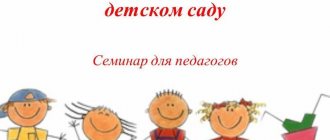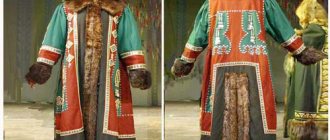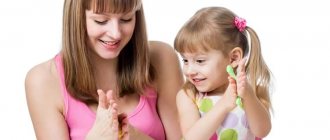CHILDHOOD GUIDE
In accordance with the Federal State Educational Standard for preschool education, the main types of activities for young children are: - object-based activities and games with composite and dynamic toys; — experimenting with materials and substances (sand, water, dough, etc.); - communication with adults; - joint games with peers under the guidance of an adult; — self-service and actions with household items and tools (spoon, scoop, spatula, etc.); - perception of the meaning of music, fairy tales, poems, looking at pictures; - physical activity.
Taking into account the age and psychological characteristics of young children, the organized activity should be : - event-based (connected with any event from personal experience); - rhythmic (motor and mental activity must alternate); — procedural (development of skills in everyday and gaming processes).
Activities of the teacher in each area: 1. Subject-based activities and games with composite and dynamic toys. Subject-based play activities with composite and dynamic toys are fundamental in the formation of cognitive activity, in the development of visual-effective and visual-figurative thinking in children. Composite toys include pyramids, nesting dolls, various lacing, composite and cut pictures, cubes, puzzles (large), construction sets (large), etc. Dynamic toys include spinning tops, tops, tumblers, wind-up toys, that is, those based on in which various types of movement occur: torsion, somersault, rotation. In object-based play activities, the result of the child’s action (especially with compound toys) is very important. Children’s cognitive interest is precisely supported by their own effective actions that they understand. In this way, methods of action are learned.
Tasks of the teacher: - develop cognitive interest in surrounding objects and promote active actions with them; - form play actions with a variety of story toys, the ability to use substitute objects; - develop the ability to imitate the play actions of an adult.
2. Experimenting with materials and substances (sand, water, dough, etc.). Acquaintance with the properties of objects occurs in practical research activities using the trial method. In the process of experimentation, the teacher attracts children's attention to smells, sounds, shapes, colors and other properties of objects and objects. It is necessary to show the correct ways of action, as well as provide opportunities for independent research. Do not forget to remind about the rules of safe behavior when working with sand and water (do not drink water, do not throw sand), as well as the rules of playing with small objects (do not put objects in your ear or nose; do not put them in your mouth).
The teacher’s tasks: - introduce generalized methods of studying various objects from the child’s surrounding life; - maintain cognitive activity and cognitive interest in the process of experimentation; - encourage independent experimentation with a variety of teaching materials; — enrich children’s direct sensory experience in various activities.
3. Communication with an adult. Communication is the most important event in early childhood and the main form of education. The forms and content of communication change as the child develops: emotional communication; communication based on understanding intonation, facial expressions, gestures, and then actual verbal communication. The speech of an adult is a role model. To develop communication, questions, verbal instructions, creating problem-speech situations, role-playing and communicative games, reading poems and fairy tales, experiments, dramatizations, and observations are used.
Tasks of the teacher: - contribute to the enrichment of the vocabulary; - develop the ability to ask, answer, request, make a remark; - develop the need for verbal communication.
4. Joint games with peers under the guidance of an adult. Since it is still difficult for young children to independently engage in games with peers, the teacher purposefully organizes play activities. For joint games, communicative, role-playing, musical and rhythmic games, as well as games and exercises with didactic material are recommended.
Tasks of the teacher: - promote the formation of the experience of friendly relationships with peers; — teach positive ways of communication and conflict resolution during the game; — develop emotional responsiveness when interacting with peers.
5. Self-service and actions with household utensils (spoon, scoop, spatula, etc.). The simplest skills of independence, neatness, and neatness are formed during routine moments. In this case, a prerequisite is compliance with the principle of gradual inclusion of the child in any activity to acquire self-service skills. It is necessary to emotionally involve the child in actions with household objects and tools, so learning should take place in a playful way.
Tasks of the teacher: - to develop basic self-service skills; — to develop skills of a culture of behavior that comply with norms and rules; - form substantive actions; - develop independence in everyday behavior.
6. Perception of the meaning of music, fairy tales, poems, looking at pictures. It is advisable to organize a cycle of educational game situations aimed at developing the child’s emotional world. is of particular importance in the perception of young children . Therefore, reading, storytelling, listening to music is accompanied by the display of pictures, paintings and toys. You can read how to work with pictures here.
The teacher’s tasks: - to develop the ability to look at pictures and illustrations; - develop the ability to listen and understand short, accessible songs, nursery rhymes, fairy tales and stories; — develop the ability to respond emotionally to various works of culture and art.
7. Motor activity. In addition to organizing outdoor games and exercises, the teacher must create conditions for the development of independent motor activity of children. To do this, it is necessary to enrich the developmental environment with rolling toys, carts, cars, etc., as well as sports equipment and equipment.
The teacher’s tasks: - develop children’s motor activity in all types of games; - promote the development of basic movements; — create conditions that encourage children to be physically active.
Thus, when organizing the interaction of a teacher with young children, it is necessary to: - include several different types of activities that successively replace each other; - organize activities in such a way as to avoid overtiredness in children; — enrich children’s personal experience in everyday life and play.
Dear teachers! If you have questions about the topic of the article or have difficulties in working in this area, then write in the comments .
I'll definitely help. Golovina Bela Gennadievna, site administrator. Features of the use of ICT in various types of musical activities of preschool children Development of speech in young children through theatrical activities Ensuring the psychological safety of young children during the adaptation period Development of communication skills in young children >



